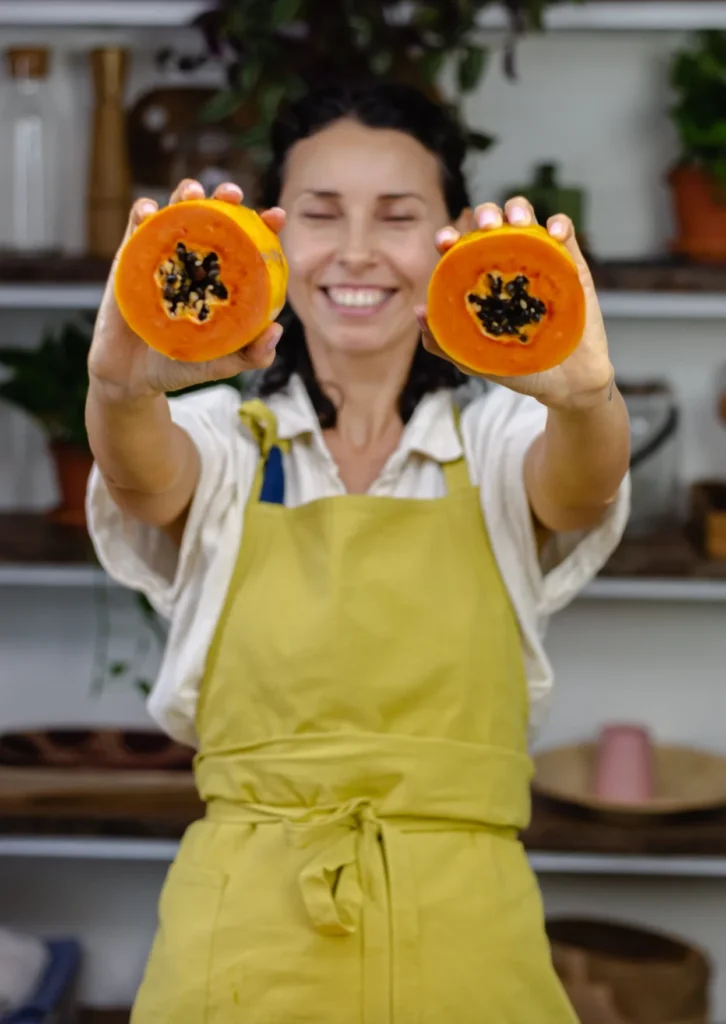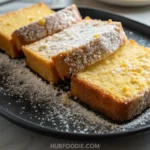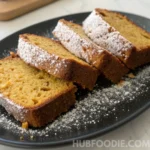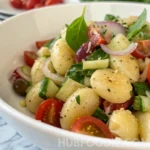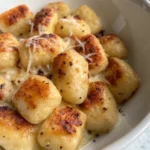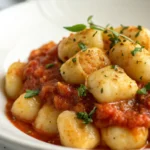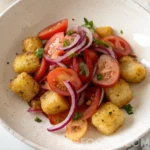I’ve always loved experimenting with green tea desserts, especially after creating our Matcha Cheesecake Recipe a hit with readers and surprisingly easy to make. But a few weeks ago, I stumbled on something even more intriguing: a matcha Basque cheesecake with a burnt top and soft, jiggly center. It looked bold, rustic, and honestly, a little mysterious.
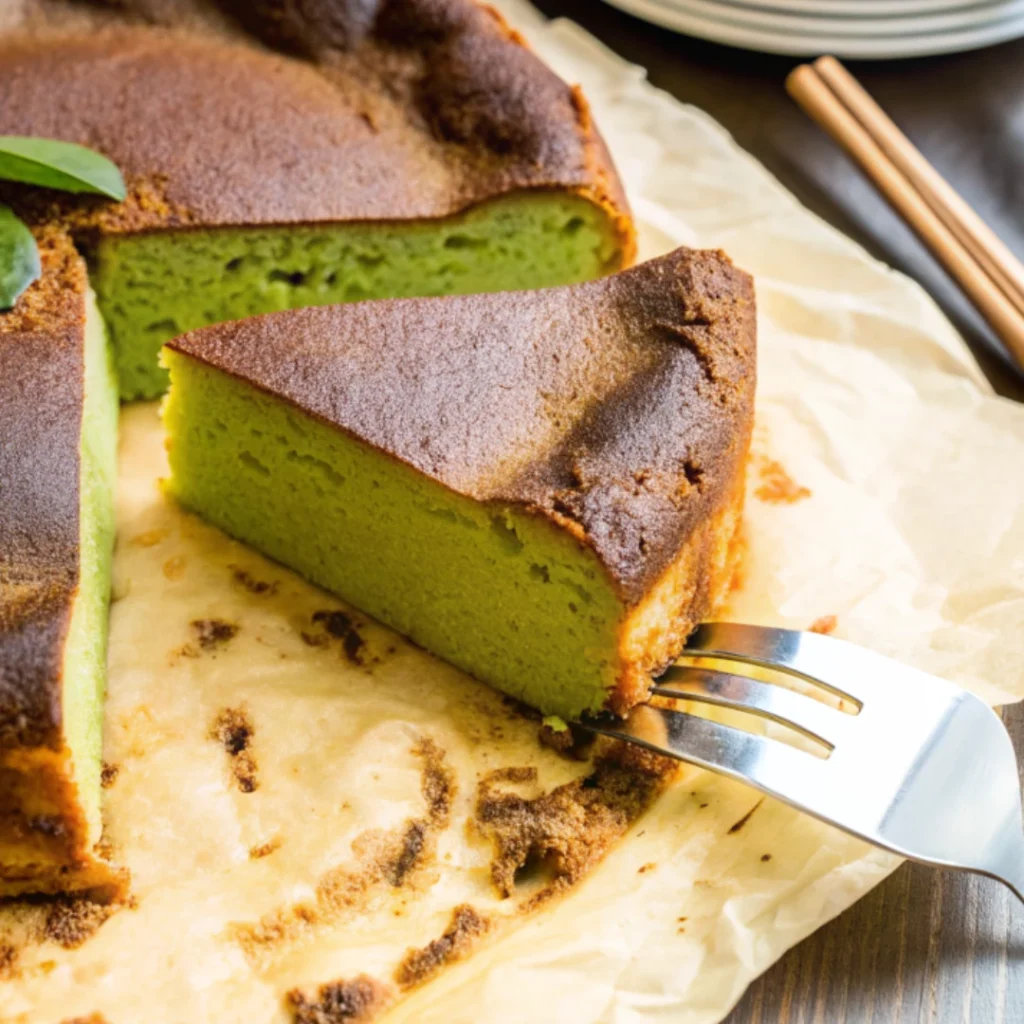
Curiosity won. I grabbed my springform pan, mixed matcha into the cream cheese batter, cranked up the oven, and let it bake until the top was beautifully scorched. The result? A smoky, caramelized surface that gave way to a creamy, bittersweet matcha middle.
That first bite convinced me: matcha burnt Basque cheesecake is a must-try. It’s not just a twist on a trendy dessert, it’s a full-flavored experience that blends Japanese and Spanish influences in the most delicious way.
Table of Contents
The Allure of Matcha Basque Cheesecake
What is Matcha Basque Cheesecake?
I still remember the first time I laid eyes on a matcha Basque cheesecake, it looked like something I wasn’t supposed to bake. No crust, cracks all over, and that burnt top? It broke every cheesecake “rule” I thought I knew. But I was fascinated.
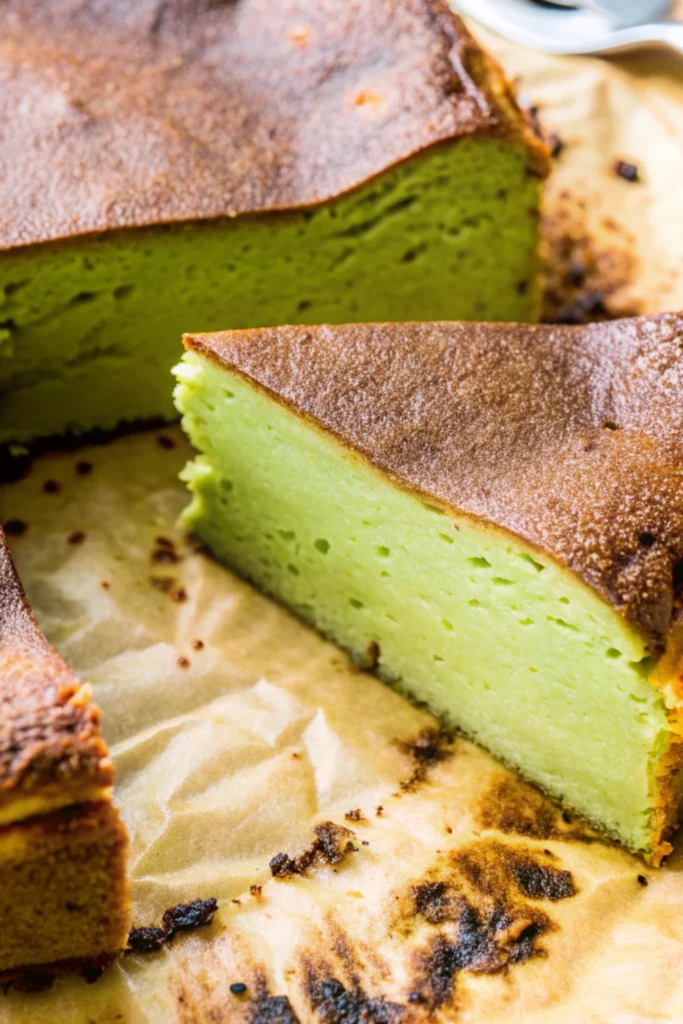
Once I understood what it was, I couldn’t wait to try it myself.
At its core, a matcha Basque cheesecake is a fusion dessert. It blends the creamy richness of a Spanish-style Basque cheesecake with the earthy, slightly bitter notes of Japanese matcha powder. It’s bold but balanced, charred on the outside, soft and custardy inside, and filled with that vibrant green glow only real matcha can give.
No water bath, no fancy crust, just high heat, good ingredients, and patience.
When I first pulled it out of the oven, I wasn’t sure I had done it right. The top looked… scorched. But once it cooled and I sliced into the soft center, I knew it was exactly how it was supposed to be. That burnt flavor paired so beautifully with the creamy texture and green tea, it blew my expectations away.
Why I Fell in Love with This Matcha Burnt Basque Cheesecake
There’s something magical about combining matcha with Basque-style cheesecake. The matcha’s earthy bitterness cuts through the richness of the cream cheese. It tones down the sweetness just enough and adds depth you don’t get with plain vanilla or fruit flavors.
What surprised me most? The texture.
It’s not dense like a New York cheesecake, and it’s not light like a Japanese one either. It sits somewhere perfectly in between silky, smooth, and slightly jiggly in the center. And that burnt top? It’s not just for looks. It adds a toasted, almost smoky flavor that balances everything out.
Ever since I made it the first time, I’ve been hooked. It’s now one of my go-to desserts when I want to impress without too much effort. And if you’ve already tried my Matcha Cheesecake Recipe, this is the bolder, deeper version you didn’t know you needed.
Want a lighter, dairy-free version? You’ll love the Raw Vegan Matcha Cheesecake. I still make that one when I want something quick and chilled.
Ingredients Breakdown for Matcha Burnt Basque Cheesecake
How I Choose the Right Matcha for the Perfect Basque Texture
The first time I made a matcha basque cheesecake, I didn’t realize how much the type of matcha would affect the outcome. I used what I had in my pantry, just a generic green tea powder. Big mistake. The color was dull, and the flavor was almost bitter in a bad way. That’s when I decided to dig deeper into matcha quality.
There are two types I’ve worked with since: ceremonial grade and culinary grade.
- Ceremonial grade matcha is what I reach for when I want that bright green color and smooth, slightly sweet finish. It’s delicate and perfect when I want the flavor to be gentle.
- Culinary-grade matcha, on the other hand, is a bit stronger. It’s more bitter, but in a good way, it stands up to high heat, which makes it ideal for baking something like a matcha burnt basque cheesecake.
Now, every time I make this recipe, I use high-quality culinary matcha for that vibrant color and bold, earthy taste. It transforms a simple matcha basque cheesecake into something deep and layered.
My Must-Have Ingredients for a Creamy, Dreamy Matcha Cheesecake
The beauty of a matcha basque cheesecake is that it doesn’t ask for much. The ingredients are simple, but you have to get them right. Here’s what I always use, and why:

| Ingredient | Why I Use It |
|---|---|
| Full-Fat Cream Cheese | It’s the heart of the cheesecake rich, tangy, and smooth. |
| Granulated Sugar | Just enough to balance the slight bitterness of matcha. |
| Large Eggs | A tablespoon is enough, it helps the cake set without being cakey. |
| Heavy Cream | Adds that silky texture I love in a well-baked cheesecake. |
| All-Purpose Flour | A tablespoon is enough it helps the cake set without being cakey. |
| Matcha Powder | The flavor hero. I sift it to avoid clumps and ensure even color. |
| Vanilla Extract (optional) | Just a splash when I want to mellow out the matcha. |
I don’t use a crust. That’s the best part of making a matcha basque cheesecake, no graham cracker fuss, no pressing into a pan, no water bath. Just parchment paper, high heat, and a rich batter that does all the work.
Every time I bake it, the kitchen fills with this deep roasted aroma from the cream cheese and that burnt top forming. And when I cut into the soft green center of a fresh matcha burnt basque cheesecake, it’s one of those moments that makes the mess worth it.
If you’re not in the mood to bake but still want matcha flavor, you can always try my Raw Vegan Matcha Cheesecake. It’s no-bake, dairy-free, and just as satisfying more lightly.
How I Make Matcha Basque Cheesecake (Step-by-Step)
Prepping the Pan and Oven – My Favorite Shortcut
When I first made matcha basque cheesecake, I expected it to be complicated like most traditional cheesecakes. I was so wrong.
There’s no crust, no water bath, and no worrying about cracking. The beauty of a matcha burnt basque cheesecake is that it’s meant to be rustic and imperfect. I love that.
I always start by lining a 9-inch springform pan with parchment paper. I don’t trim the edges too perfectly. I let the paper extend above the rim. This helps the cake puff up and gives it that iconic ruffled look.
Then, I preheat the oven to 425°F (218°C). This high temperature is crucial. It’s what gives the top that dramatic burnt finish while keeping the center soft and creamy.
My Go-To Matcha Basque Cheesecake Recipe (In 6 Easy Steps)
I’ve made this so many times now, I could probably do it with my eyes closed, but here’s exactly how I do it, step by step.
Step 1: Cream Cheese and Sugar First
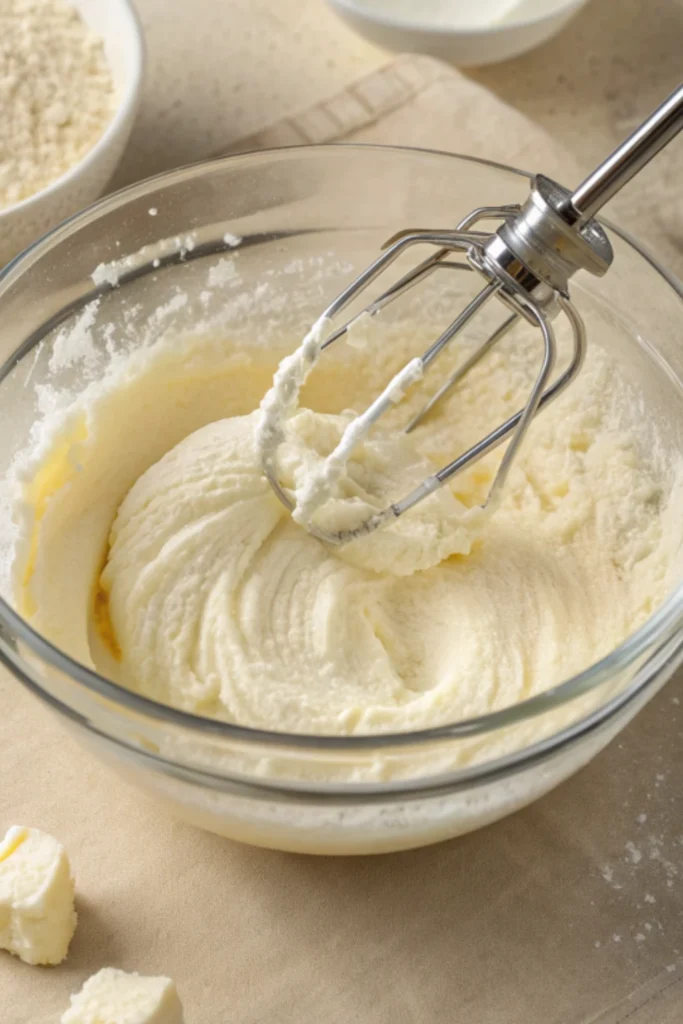
I always start by beating room-temperature cream cheese with granulated sugar. I use a hand mixer for 2–3 minutes until it’s smooth and fluffy. Getting this part right gives the cheesecake its signature texture.
Step 2: Add the Eggs Slowly
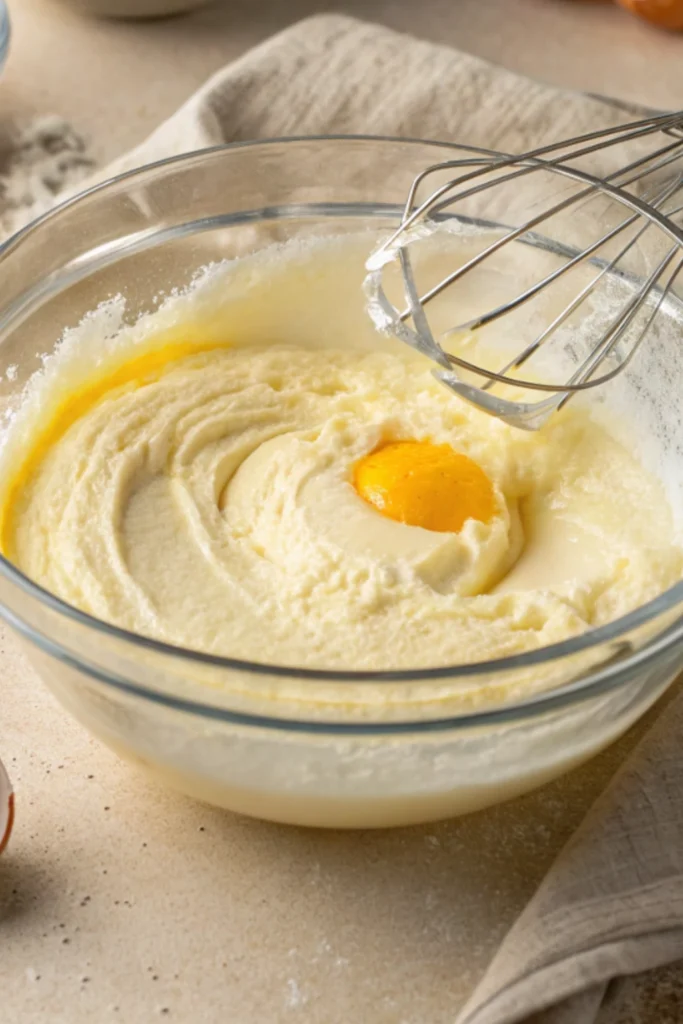
Next, I crack in the eggs one at a time. I mix each one until just combined. Overbeating can make the batter too airy, so I take it easy here.
Step 3: Time for the Matcha

This is my favorite part. I sift in the matcha powder directly into the bowl, never skip the sifting! It prevents bitter clumps and gives the cheesecake a smooth, even color. I mix until the batter turns that dreamy green I’ve come to crave.
Step 4: Add Cream and Flour

Then I pour in the heavy cream and mix it gently. I also add a tablespoon of flour to help the cheesecake set, but not so much that it turns cakey. Sometimes I toss in a little vanilla extract to round out the flavor.
Step 5: Bake It Bold
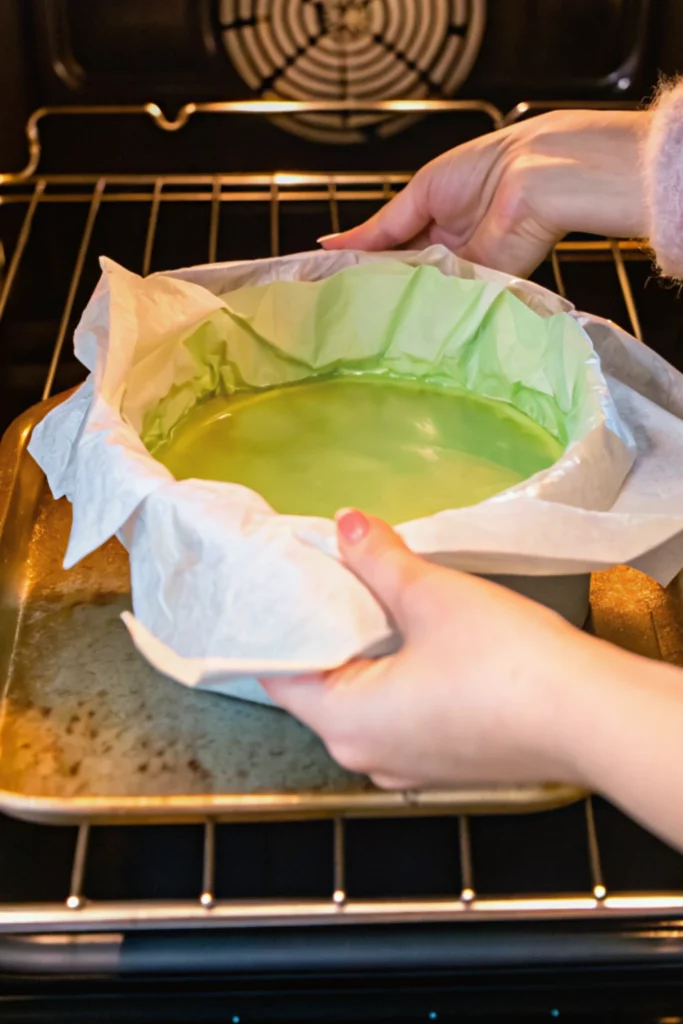
I pour the batter into my lined pan and smooth out the top. Then it’s straight into the oven. I usually bake it for 30–35 minutes. Around minute 30, I check the top, it should be a deep golden brown with a few darker spots. That’s how I know I’ve nailed it.
The center should still jiggle a little when I gently shake the pan. That’s not underbaked, it’s perfect.
Step 6: Cool and Chill
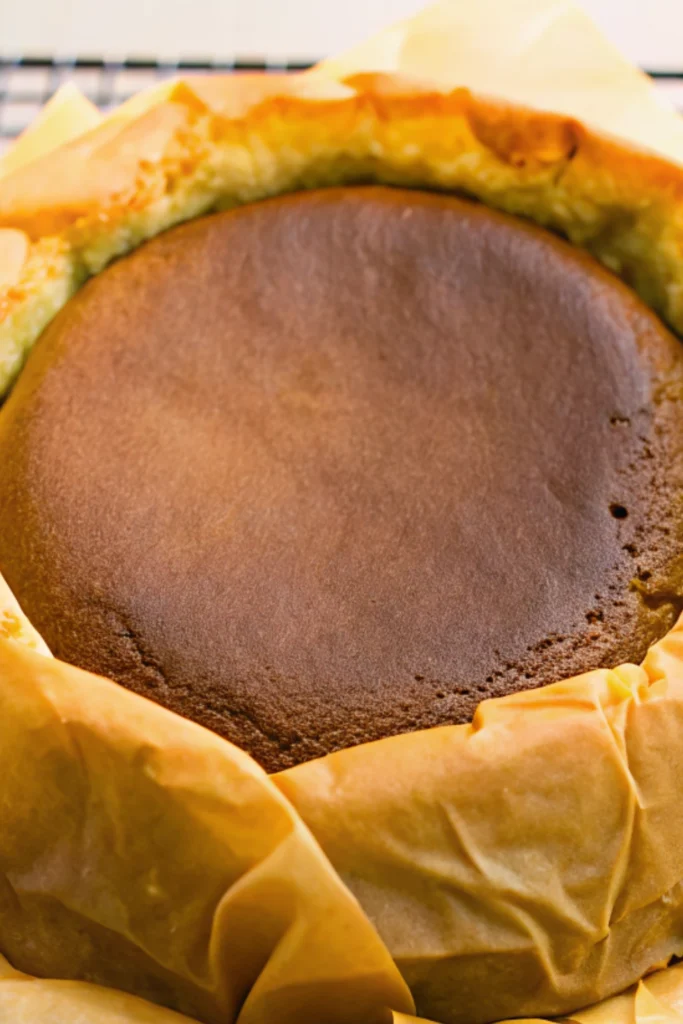
This part is hard… because I always want to slice it right away. But I let it cool in the pan first. After that, I chill it in the fridge for at least 4 hours, and overnight is even better.
When it’s ready, I remove the parchment and slice into that golden-brown crust. The inside? Creamy, green, and so satisfying.
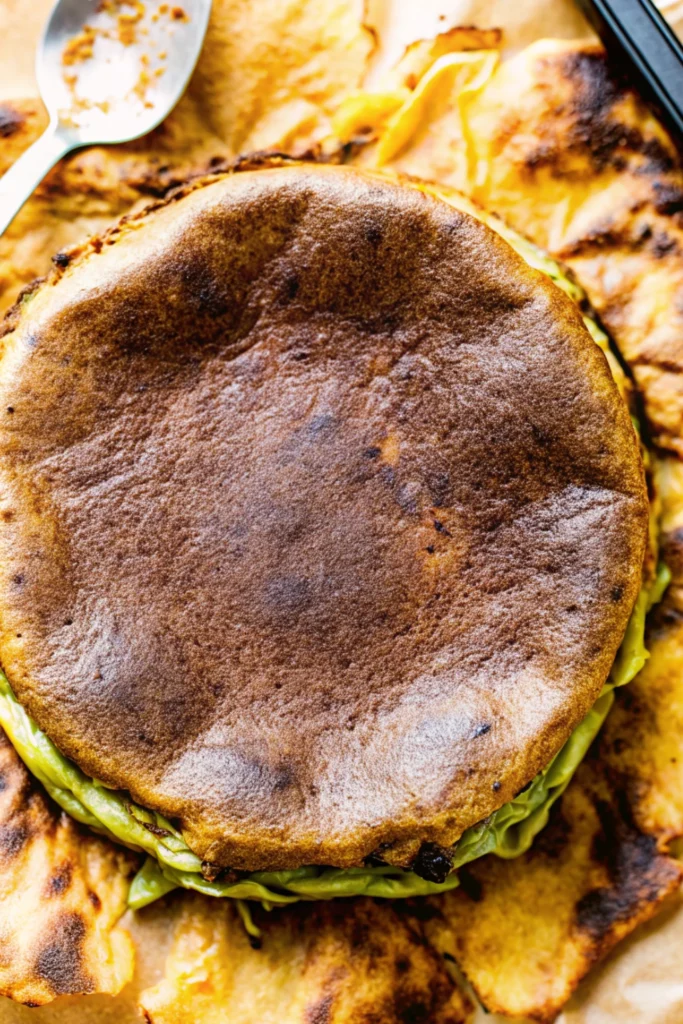
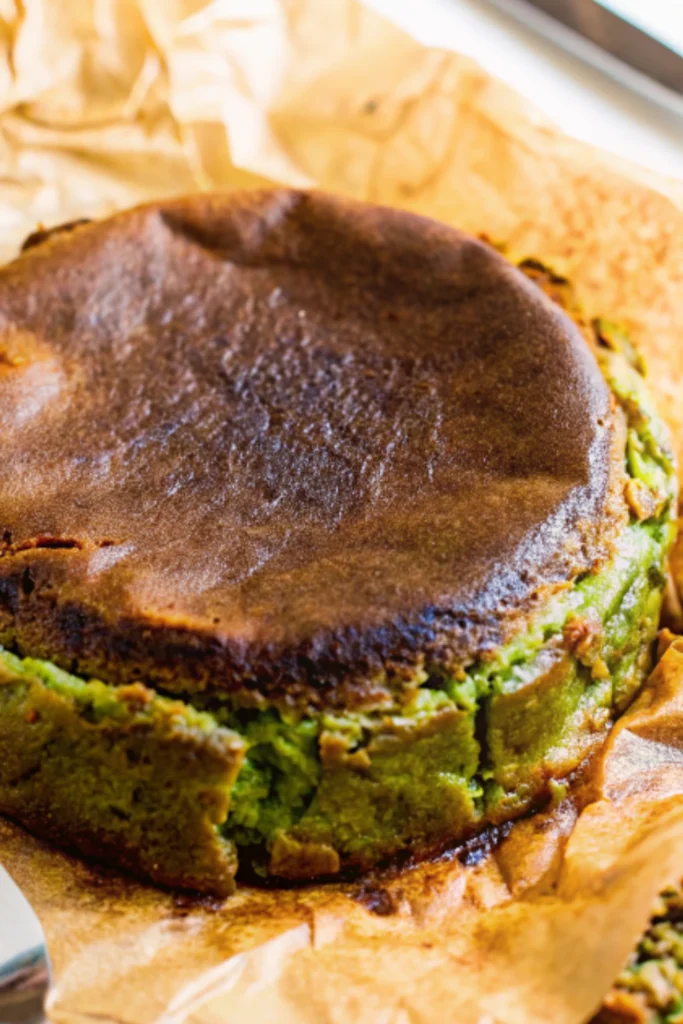

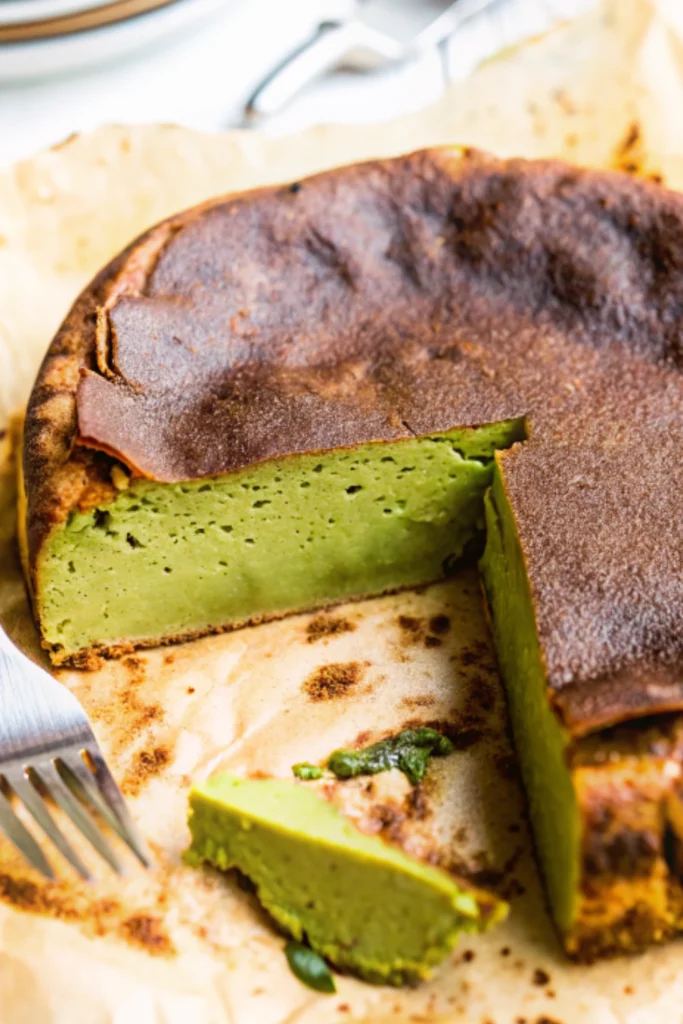
Baking this matcha basque cheesecake has become a ritual for me. Whether I’m making it for friends or just to unwind on the weekend, it never disappoints.
Looking for something quicker to satisfy that matcha craving? Try one of my Quick & Easy Raw Vegan Recipes. Perfect for snack prep or summer treats.
Health Insights – Is Matcha Basque Cheesecake Healthy?
Is Baking with Matcha Good for You?
When I first started baking with matcha, I was honestly just drawn to the color and the flavor. But the more I worked with it, especially in recipes like this matcha basque cheesecake, the more I appreciated its health benefits, too.
Matcha is packed with antioxidants, especially EGCG (epigallocatechin gallate), which is known for fighting inflammation and boosting metabolism. It also has L-theanine, which helps with focus and calmness, unlike the jittery caffeine buzz you get from coffee.[Source]
So yes, when I add matcha to a dessert like this, it does bring a little wellness boost. Sure, it’s still cheesecake, but it’s nice knowing there’s something good mixed in with all that creamy indulgence.
And because matcha burnt basque cheesecake isn’t overly sweet, it doesn’t spike my energy the way sugar-heavy desserts sometimes do.
Basque vs. Traditional Cheesecake: Which One’s Lighter?
A lot of readers have asked me: Is Basque cheesecake healthier than the regular kind?
In my experience, yes, at least in a few key ways:
- No crust means fewer refined carbs
Basque cheesecakes skip the buttery cookie or graham cracker base, which instantly cuts down on fat and sugar. - Less sugar overall
My recipe uses just enough sugar to balance the matcha, but nowhere near the amount in a dense New York-style cheesecake. - Fewer ingredients, fewer preservatives
When I make this matcha basque cheesecake at home, I know every ingredient in it. No stabilizers, no additives, just whole foods.
Here’s a quick breakdown of how they compare:
| Feature | Basque Cheesecake | Traditional Cheesecake |
|---|---|---|
| Crust | No | Yes (cookie or graham base) |
| Sugar Content | Lower | Higher |
| Bake Style | High heat, no water bath | Low temp, water bath |
| Texture | Creamy & slightly jiggly | Dense & firm |
| Flavor Profile | Smoky, earthy, balanced | Sweet, rich, vanilla-heavy |
On days when I want something indulgent but not heavy, I always go with a slice of matcha burnt basque cheesecake. It feels more balanced and less overwhelming than traditional versions, and I never miss the crust.
Discover great ideas like our Green Velvet Cheesecake if you’re curious about other unique flavor twists that still keep things relatively wholesome.
Basque vs. Japanese Cheesecake – What’s the Difference?
What I Noticed the First Time I Made Both
I still remember the week I made both a classic Japanese cheesecake and a matcha basque cheesecake back-to-back. It felt like I was baking in two completely different worlds.
The Japanese version was light and airy, almost like a soufflé. It took a water bath, gentle folding, and lots of patience. When I sliced it, it jiggled like a cloud. The matcha burnt basque cheesecake, on the other hand, was bold, rustic, and rich. No water bath. No folding. Just high heat, a burnt top, and that creamy, earthy center.
They couldn’t be more different, and that’s what I love about them.
Basque Cheesecake is Bold, Japanese Cheesecake is Subtle
Here’s how I break it down when people ask me about the difference:
- Texture:
The Basque cheesecake is dense, custardy, and slightly gooey in the center. That burnt top gives it structure and depth. Japanese cheesecake is lighter, almost spongy. It melts in your mouth with no resistance. - Flavor:
Matcha burnt basque cheesecake has an earthy, roasted flavor from both the matcha and the caramelized top. Japanese cheesecake is milder, sweeter, and more egg-forward, and often flavored with lemon or vanilla. - Prep Style:
One of the biggest contrasts? Technique. Japanese cheesecakes require folding egg whites, carefully timed baking, and water baths. With matcha basque cheesecake, I just mix, pour, and bake at high heat. It’s more forgiving, and honestly, it feels less stressful.
A Quick Comparison from My Own Baking Experience
| Feature | Matcha Basque Cheesecake | Japanese Cheesecake |
|---|---|---|
| Texture | Creamy, dense, and slightly gooey | Low heat with a water bath |
| Baking Method | High heat, no water bath | Usually, no crust either |
| Crust | No crust | Usually no crust either |
| Flavor Style | Bold, smoky, earthy (with matcha) | Delicate, eggy, lightly sweet |
| Skill Level | Beginner-friendly | More technical |
While I love both styles, I find myself coming back to matcha basque cheesecake more often. It’s faster, more flexible, and easier to personalize. I can tweak the sweetness, adjust the matcha, or even add yuzu or black sesame, and it always comes out beautiful in its imperfect way.
Don’t miss our Watermelon Fries and Strawberry Dip if you’re looking for a fun, refreshing contrast to your next baking session, sweet, juicy, and no oven required.
Expert Tips and Common Mistakes to Avoid
What I Wish I Knew Before Baking My First Matcha Basque Cheesecake
The first time I made a matcha basque cheesecake, I thought it would be foolproof. I mean, no crust? No water bath? High heat? Easy, right?
Not quite.
That first attempt turned out edible but barely. The top was too burnt, the matcha was clumpy, and the center never set properly. Since then, I’ve tested this recipe over a dozen times, and every mistake became a lesson.
If you’re trying your hand at matcha burnt basque cheesecake, here’s everything I wish I knew from the start.
Mistake #1: Using Low-Quality Matcha
I can’t stress this enough: the matcha you use matters. I’ve tested a few cheap options before, and the color came out muddy, and the flavor was borderline grassy.
Tip: Always sift your matcha, and go for a vibrant, fine powder. I use a high-grade culinary matcha that gives the cake its rich green color and signature earthy bite. If your powder is dull or brownish, skip it, it’ll ruin the flavor.
Mistake #2: Overbaking (Yes, It’s Still Possible)
Even though this is a “burnt” cheesecake, you still don’t want it too burnt. I once left it in the oven for 40 minutes, thinking darker was better. The top was black, and the inside dried out. Not fun.
Tip: Bake at 425°F (218°C) for 30–35 minutes and watch closely near the end. When the top is deeply golden and cracked, and the center still jiggles slightly, it’s done.
Mistake #3: Skipping the Chill Time
I get it, waiting is hard. But this cheesecake needs time to set and cool down. If you cut into it too early, you’ll lose that creamy center.
Tip: Cool it completely at room temperature, then chill in the fridge for at least 4 hours, preferably overnight. Trust me, the texture the next day is always better.
Mistake #4: Burning Your Matcha
Yes, you can burn your matcha, but not in the way you’d think. I once added boiling water to the powder while trying a glaze idea, and it turned bitter fast.
Tip: Keep matcha cool until it hits the oven. Don’t mix it with super-hot ingredients. And never skip sifting, it keeps your batter smooth and lump-free.
Mistake #5: Forgetting the Parchment Paper
The parchment lining gives the matcha basque cheesecake its iconic shape and makes cleanup easy. I forgot it once. Just once. Let’s just say I had to chisel that cheesecake out of the pan.
Tip: Use one large sheet of parchment that covers the bottom and rises a couple of inches above the rim. It gives the cake room to rise and fall naturally.
Over time, I’ve learned that every small detail matters, from the type of matcha to the cool-down time. And honestly, the more I bake this, the better it gets.
Looking for inspiration beyond cheesecake? You might enjoy our Blueberry Vegan Ice Cream for a cool, fruity twist after a rich slice of cheesecake.
Creative Variations and Serving Ideas
How I Like to Personalize My Matcha Basque Cheesecake
Once I had my go-to matcha basque cheesecake recipe down, I started getting creative with it. I love that it’s so adaptable. You can keep it classic, or turn it into a centerpiece dessert with just a few tweaks.
Whether you’re baking for friends, holidays, or just spicing up your Sunday, here are some of my favorite ways to remix the original.
Add a Twist with These Simple Flavor Upgrades
I usually stick to the original base, but once in a while, I’ll mix in an extra ingredient or two for a new take. These variations have become some of my most requested bakes:
- White Chocolate Matcha Basque Cheesecake
I melt about ½ cup of white chocolate and stir it into the batter before baking. It adds sweetness and pairs beautifully with the matcha’s earthy tones. - Black Sesame Swirl
I swirl in a spoonful of black sesame paste right before pouring the batter into the pan. The color contrast is gorgeous, and the nutty flavor brings depth. - Yuzu Zest or Juice
A little yuzu (or even lemon zest if you can’t find it) adds a citrusy lift that cuts through the richness. I like adding it directly to the batter or grating zest on top before serving.

How I Serve It for Maximum Impact
I’ve served this matcha burnt basque cheesecake in all kinds of ways, from casual slices with tea to dressed-up plates at holiday dinners. Here are some simple serving ideas that always wow my guests:
- With Fresh Berries
A few raspberries or blueberries on the side not only brighten the plate but also balance the rich flavor. I usually go with tart fruits that cut through the creaminess. - Dusting of Matcha or Powdered Sugar
Right before serving, I sift a tiny bit of matcha on top for color or add powdered sugar for contrast. It’s a small touch, but it makes a big difference in presentation. - Drizzle of Sweetened Condensed Milk or Honey
Just a drizzle across the slice adds sweetness and makes each bite even more indulgent. - Mini Versions
I sometimes bake these in ramekins for individual servings. Perfect for parties or gifting, and no slicing required.
Make It a Full Dessert Table
If I’m hosting and want to offer more than one option, I’ll often pair this cheesecake with something fruity and light. One of my favorites is our Green Cheesecake Recipe, which gives a fun twist to color and flavor without competing too much with the boldness of matcha.
The beauty of matcha basque cheesecake is that it’s elegant enough to serve as-is, but flexible enough to be whatever you want it to be. Sweet, citrusy, nutty, even vegan (if you’re feeling experimental), there’s room to make it your own.
Storing, Freezing & Reheating Matcha Cheesecake
How I Store My Matcha Basque Cheesecake
Whenever I bake a matcha basque cheesecake, I try to make it a day ahead. Why? Because the texture improves after chilling. Once it’s cooled completely at room temperature, I loosely cover it with parchment paper and pop it in the fridge.
It keeps well for up to 4–5 days, and I usually store it in the same springform pan with a plate or cake dome on top. If you prefer storing slices, I place parchment between each piece to keep them from sticking together.
The flavor deepens after day one, and the texture firms up in the best way, still creamy, but easier to slice cleanly.
Freezing Matcha Burnt Basque Cheesecake (Yes, It Works!)
I didn’t freeze a cheesecake for the first few years I baked. I always thought it would mess with the texture. But after trying it with my matcha burnt basque cheesecake, I was pleasantly surprised that it freezes beautifully.
Here’s how I do it:
- Cool it completely in the fridge.
- Slice into portions or freeze whole, both work.
- Wrap tightly in plastic wrap, then foil.
- Store in the freezer for up to 1 month.
When I’m ready to serve, I just thaw it overnight in the fridge. I’ve also let slices sit at room temp for about 30–40 minutes when I’m in a hurry.
Pro tip: For a frozen treat, I’ve even eaten it semi-frozen. It tastes a bit like a matcha cheesecake ice cream bar.
How I Reheat It (When I Want It Warm and Gooey)
Okay, I know cheesecake is usually served chilled, but once in a while, I crave that soft, warm texture. When I do, I reheat a slice gently.
Here’s what I do:
- Microwave it on medium power for 10–15 seconds.
- Or pop it in the oven at 300°F (150°C) for 5 minutes.
This brings back some of that just-baked softness without drying it out.
But honestly? Most days, I enjoy it straight from the fridge with a hot matcha latte or black tea. It’s the perfect balance of cool and rich.
Looking for another easy recipe to prep ahead? Don’t miss our Green Cheesecake Recipe, a chilled dessert that’s equally fun and flexible for planning.
FAQs About Matcha Basque Cheesecake
1. What is matcha Basque cheesecake?
It’s a crustless, high-heat-baked cheesecake made with matcha powder for that earthy green tea flavor and a gorgeous color. The top is intentionally burnt (yep, on purpose!), giving it a smoky caramelized finish that balances the creaminess inside. My version of matcha basque cheesecake is rustic, bold, and easier to make than most people expect.
2. What does matcha cheesecake taste like?
If you’ve never tried matcha in desserts, it has a rich, earthy, slightly bitter flavor, kind of like strong green tea with umami. In cheesecake form, it pairs perfectly with the tangy cream cheese and subtle sweetness. When I bake matcha burnt basque cheesecake, I always get that deep roasted note from the top crust, which adds a smoky edge to the green tea flavor.
3. What is so special about Basque cheesecake?
For me, it’s the simplicity. No crust, no water bath, and it embraces imperfection. The burnt top gives it a unique flavor and a dramatic look, while the inside stays soft and luscious. With matcha basque cheesecake, the flavor gets even more complex, blending toasted caramel notes with the bitterness of matcha.
4. Is Basque cheesecake healthier than regular cheesecake?
In some ways, yes! It doesn’t have a crust (so fewer refined carbs), and you can control the sugar more easily. When I make matcha basque cheesecake, I keep the sugar low since the matcha already gives it so much character. It feels lighter than a dense, traditional cheesecake, even though it’s still wonderfully indulgent.
5. What is the difference between Japanese and Basque cheesecake?
Oh, this is one of my favorite comparisons! Japanese cheesecake is fluffy and soufflé-like; it’s jiggly and super light. Basque cheesecake, on the other hand, is creamy, dense, and has that signature burnt top. When I want bold flavor and a quick bake, I go for matcha burnt basque cheesecake. When I want something airy and delicate, I’ll make a Japanese-style one.
6. How to make matcha burnt cheesecake?
It’s surprisingly simple! I mix cream cheese, sugar, eggs, heavy cream, sifted matcha powder, and a touch of flour. Then I bake it at high heat, 425°F (218°C) for about 30–35 minutes until the top is deeply golden. If you need a detailed step-by-step, scroll back to Part 3, where I walk through my exact method for baking matcha burnt basque cheesecake at home.
7. Is burnt cheesecake the same as Basque cheesecake?
Yes, they’re the same thing! The “burnt” name comes from the top layer that caramelizes under high heat. I use “Basque” when I’m referring to the origin (from the Basque region of Spain) and “burnt” when I’m talking about the visual and flavor. My matcha basque cheesecake recipe is both crustless, creamy, and beautifully scorched on top.
8. Is baking with matcha healthy?
It can be! Matcha is packed with antioxidants like EGCG and offers a calm, focused kind of energy thanks to the L-theanine. While matcha basque cheesecake is still a dessert, adding matcha does give it a wellness boost. I love using it for that vibrant color and earthy flavor, but the health benefits are a sweet bonus.
9. What happens if you burn your matcha?
I’ve done it. It’s not pretty. When matcha is exposed to high heat before it’s mixed into batter, it can turn bitter and lose its flavor. That’s why I always sift it into the batter once everything else is mixed and never add it to hot liquids. In a matcha burnt basque cheesecake, the matcha bakes gently inside the batter, so it keeps its integrity without getting scorched.
Conclusion
Baking a matcha basque cheesecake is one of those experiences that’s both comforting and exciting. I love how the high heat transforms the top into a deep golden crust while the center stays creamy, rich, and infused with that unmistakable matcha flavor. It’s rustic, elegant, and far easier than it looks.
Whether you keep it classic, add a swirl of black sesame, or drizzle it with condensed milk, this dessert never fails to impress. And the best part? You can make it ahead, chill it, and enjoy it over several days or freeze slices for a matcha treat anytime.
If you’ve been looking for a cheesecake recipe that’s bold yet simple, matcha burnt basque cheesecake might just become your new go-to bake.
👩🏻🍳 Recipe
Print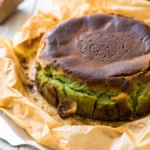
matcha Basque cheesecake
- Prep Time: 15 minutes
- Cook Time: 35 minutes
- Total Time: 50 minutes
- Yield: 8 slices
- Category: Dessert
- Method: Baked
- Cuisine: Japanese Fusion, Basque-Inspired
- Diet: Vegetarian
Description
This Matcha Basque Cheesecake is a vibrant twist on the traditional burnt Basque-style dessert. Creamy, crustless, and boldly flavored with premium matcha green tea powder, it’s baked at high heat for a dramatic caramelized top and a soft, custardy center. Perfect for matcha lovers and cheesecake fans alike.
Ingredients
- 500g (about 2 cups) full-fat cream cheese, room temperature
- 200g (1 cup) granulated sugar
- 4 large eggs, room temperature
- 240ml (1 cup) heavy cream
- 1 tbsp all-purpose flour (optional for stability)
- 2 tbsp matcha powder (culinary grade, sifted)
- 1 tsp vanilla extract (optional)
- Parchment paper (for lining)
Instructions
- Preheat your oven to 425°F (218°C). Line a 9-inch springform pan with parchment paper, allowing the edges to overhang.
- In a large mixing bowl, beat cream cheese and sugar together until smooth and fluffy.
- Add eggs one at a time, mixing well after each addition.
- Sift in the matcha powder and gently mix until fully incorporated.
- Pour in heavy cream and mix until the batter is smooth. Stir in flour and vanilla if using.
- Pour the batter into the prepared pan and smooth the top.
- Bake for 30–35 minutes or until the top is golden-brown and slightly burnt. The center should jiggle slightly.
- Let the cheesecake cool completely at room temperature, then refrigerate for at least 4 hours or overnight.
- Slice and serve chilled or slightly warm.
Notes
Always sift the matcha powder to avoid clumps and bitterness.
You can reduce the sugar slightly if your matcha is mild or you prefer a less sweet dessert.
For a stronger flavor, use ceremonial-grade matcha, but culinary grade is recommended for baking.
The cheesecake will puff during baking and sink slightly as it cools. This is normal.
Freezes well for up to 1 month when tightly wrapped.
Love what you see? Follow me on Facebook and Pinterest for more easy, delicious recipes and daily inspiration!

